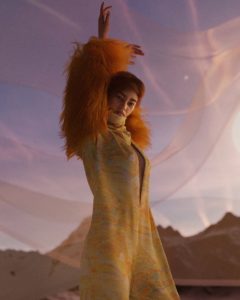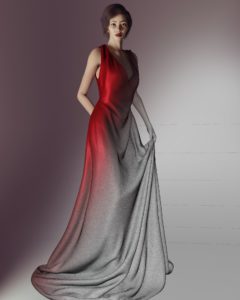Want to know what it’s like to run a modeling agency without actual models? We found someone with the answer.
Singaporean fashion photographer Shavonne Wong was unemployed and bored of playing video games during the pandemic “circuit breaker,” so she picked up new skills online and started creating virtual models on her laptop, complete with hair, makeup, accessories, and outfits. In August, she launched virtual modeling agency Gen V.
“The circuit breaker has been very helpful because being stuck at home meant that I could stay on the computer for 14 hours a day watching YouTube tutorials because I had to learn all the software that I didn’t learn back then,” she told Coconuts.
Singapore entered a two-month partial lockdown it euphemistically called a “circuit breaker” in April to limit the further spread of COVID-19. Industries including fashion and art deemed nonessential were not allowed to operate and nearly every resident told to work from home.
Wong’s virtual agency was a stroke of genius considering the restrictions on socializing and physical contact as fashion shows and shoots were potential hotbeds for the coronavirus. But Wong also felt that a change was long overdue for the fashion industry, which thrives on setting the latest trends in clothing but not so much in technology.
“I’ve been noticing that the fashion industry, for an industry that prides itself to be very modern and trendy, has somehow lagged behind at improving itself in a technological sense,” the 29-year-old said. “It has stuck to a very traditional way of doing things, the way it has always been done.”
Wong was referring to the old-fashioned and highly wasteful ways the fashion industry operates by producing tonnes of clothes largely for the two main spring/summer and fall/winter seasons. The industry has been producing even more clothes in recent years with the emergence of fast fashion outlets like H&M and Zara making clothes that look outdated more quickly than before.
Wong said that this industry habit has resulted in “a lot of unsold inventory,” a problem which Wong thinks can be solved by switching out traditional fashion shows and clothes with digital ones using 3D-rendered models.
“These are all issues that can, I believe, technology can help with, doing virtual shows and waiting for customers to show interest before manufacturing, etc,” she said.
Meet Kade, Lilium, and Lunah

Wong has created three virtual models she named Kade, Lilium, and Lunah under her agency and has since lent their faces to local fashion publications Nuyou and Female. She did all that without a proper office, studio, wardrobe, models, hair stylists or makeup crew – just her and her laptop.
“As of now, my main three models do differ [in physical appearance] but not too much as I need them to be around the general model body shape so if I do a virtual runway, their bodies are consistent enough. They’re all really blank slates with different faces and everything,” Wong said.
The first model she created, Kade, was initially meant to look East Asian, but that plan fell through due to the lack of references.

“I feel like with these virtual models it’s also nice to have an ambiguity to their races also, you don’t think of them as just the race but more relatable to more people or interesting looking so I wouldn’t say they are very clearly a certain race or anything,” Wong said. She is also looking to diversify the look of her models and expects to introduce plus-sized model Vanesse as well as Lexi, who has heterochromia iridum, a condition where the eyes appear in different colors.
“Eventually the whole idea of the agency is to provide more looks, different kinds of diversity in a sense of different skin tones, body shape, body sizes, age and gender, a broad range that clients can choose from,” she said.
Wong also intentionally gave her models’ unique names so that they can stand out on social media.
Wong is also no stranger to beauty and fashion, counting brands like Sephora and Lancome among her clients. She was also a guest photographer throughout the 10 years of the reality show Asia’s Next Top Model.
The process

Wong spends at least two weeks creating a single model, which involves basic 3D animation techniques she learned back in polytechnic school. She used online tutorials and poured through piles of references of real-life models to digitally sculpt their hair, eyebrows, eyelashes, and even pores.
Then there are also changes she makes to the models based on client request, which can drag out the process further.
“The amount of revisions that can be asked is also more just because everything can be changed as compared to when I do a photoshoot where if you want to change the picture we have to go back and reshoot,” Wong said of real life vs. virtual fashion shoots.

She has even dressed her virtual models in the latest Prada outfits in collaboration with 3D virtual clothing company Vas3D. Making a virtual outfit can take up to a full day depending on how complicated the clothing is, with the most time-consuming task involving cutting out clothing patterns.
Wong also has plans to add motion to her static virtual models so that they can walk on runways or even take on hosting jobs.
“My plan is to figure out facial motion capture and motion capture in general so the models aren’t just used for fashion, they can be used for activation, for virtual runways and hosts for events,” she said.
She sees it as only the beginning.
“With Gen V, I feel like there’s a lot of potential and there are many directions we can go so I’m very open to seeing what happens and I’ll be working on it till it becomes big,” she said.
Other stories you should check out:
Meet Ava Gram, Singapore’s woke, fashionable and gender-fluid influencer
Watch Singapore rise and fall in athletic filmmaker’s 8-year time lapse



